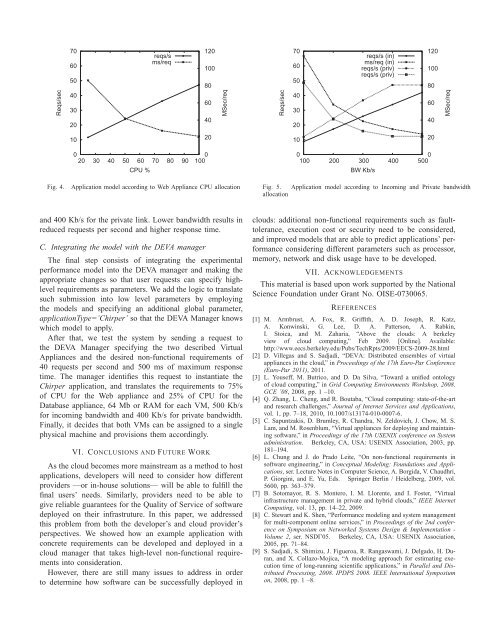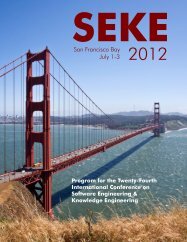Mapping Non-Functional Requirements to Cloud Applications
Mapping Non-Functional Requirements to Cloud Applications
Mapping Non-Functional Requirements to Cloud Applications
You also want an ePaper? Increase the reach of your titles
YUMPU automatically turns print PDFs into web optimized ePapers that Google loves.
Reqs/sec<br />
70<br />
60<br />
50<br />
40<br />
30<br />
20<br />
reqs/s<br />
ms/req<br />
120<br />
100<br />
80<br />
60<br />
40<br />
MSec/req<br />
Reqs/sec<br />
70<br />
60<br />
50<br />
40<br />
30<br />
20<br />
reqs/s (in)<br />
ms/req (in)<br />
reqs/s (priv)<br />
reqs/s (priv)<br />
120<br />
100<br />
80<br />
60<br />
40<br />
MSec/req<br />
10<br />
20<br />
0<br />
20 30 40 50 60 70 80 90 100 0<br />
CPU %<br />
10<br />
20<br />
0<br />
100 200 300 400 500 0<br />
BW Kb/s<br />
Fig. 4.<br />
Application model according <strong>to</strong> Web Appliance CPU allocation<br />
Fig. 5. Application model according <strong>to</strong> Incoming and Private bandwidth<br />
allocation<br />
and 400 Kb/s for the private link. Lower bandwidth results in<br />
reduced requests per second and higher response time.<br />
C. Integrating the model with the DEVA manager<br />
The final step consists of integrating the experimental<br />
performance model in<strong>to</strong> the DEVA manager and making the<br />
appropriate changes so that user requests can specify highlevel<br />
requirements as parameters. We add the logic <strong>to</strong> translate<br />
such submission in<strong>to</strong> low level parameters by employing<br />
the models and specifying an additional global parameter,<br />
applicationType=’Chirper’ so that the DEVA Manager knows<br />
which model <strong>to</strong> apply.<br />
After that, we test the system by sending a request <strong>to</strong><br />
the DEVA Manager specifying the two described Virtual<br />
Appliances and the desired non-functional requirements of<br />
40 requests per second and 500 ms of maximum response<br />
time. The manager identifies this request <strong>to</strong> instantiate the<br />
Chirper application, and translates the requirements <strong>to</strong> 75%<br />
of CPU for the Web appliance and 25% of CPU for the<br />
Database appliance, 64 Mb or RAM for each VM, 500 Kb/s<br />
for incoming bandwidth and 400 Kb/s for private bandwidth.<br />
Finally, it decides that both VMs can be assigned <strong>to</strong> a single<br />
physical machine and provisions them accordingly.<br />
VI. CONCLUSIONS AND FUTURE WORK<br />
As the cloud becomes more mainstream as a method <strong>to</strong> host<br />
applications, developers will need <strong>to</strong> consider how different<br />
providers —or in-house solutions— will be able <strong>to</strong> fulfill the<br />
final users’ needs. Similarly, providers need <strong>to</strong> be able <strong>to</strong><br />
give reliable guarantees for the Quality of Service of software<br />
deployed on their infrastruture. In this paper, we addressed<br />
this problem from both the developer’s and cloud provider’s<br />
perspectives. We showed how an example application with<br />
concrete requirements can be developed and deployed in a<br />
cloud manager that takes high-level non-functional requirements<br />
in<strong>to</strong> consideration.<br />
However, there are still many issues <strong>to</strong> address in order<br />
<strong>to</strong> determine how software can be successfully deployed in<br />
clouds: additional non-functional requirements such as fault<strong>to</strong>lerance,<br />
execution cost or security need <strong>to</strong> be considered,<br />
and improved models that are able <strong>to</strong> predict applications’ performance<br />
considering different parameters such as processor,<br />
memory, network and disk usage have <strong>to</strong> be developed.<br />
VII. ACKNOWLEDGEMENTS<br />
This material is based upon work supported by the National<br />
Science Foundation under Grant No. OISE-0730065.<br />
REFERENCES<br />
[1] M. Armbrust, A. Fox, R. Griffith, A. D. Joseph, R. Katz,<br />
A. Konwinski, G. Lee, D. A. Patterson, A. Rabkin,<br />
I. S<strong>to</strong>ica, and M. Zaharia, “Above the clouds: A berkeley<br />
view of cloud computing,” Feb 2009. [Online]. Available:<br />
http://www.eecs.berkeley.edu/Pubs/TechRpts/2009/EECS-2009-28.html<br />
[2] D. Villegas and S. Sadjadi, “DEVA: Distributed ensembles of virtual<br />
appliances in the cloud,” in Proceedings of the 17th Euro-Par Conference<br />
(Euro-Par 2011), 2011.<br />
[3] L. Youseff, M. Butrico, and D. Da Silva, “Toward a unified on<strong>to</strong>logy<br />
of cloud computing,” in Grid Computing Environments Workshop, 2008.<br />
GCE ’08, 2008, pp. 1 –10.<br />
[4] Q. Zhang, L. Cheng, and R. Boutaba, “<strong>Cloud</strong> computing: state-of-the-art<br />
and research challenges,” Journal of Internet Services and <strong>Applications</strong>,<br />
vol. 1, pp. 7–18, 2010, 10.1007/s13174-010-0007-6.<br />
[5] C. Sapuntzakis, D. Brumley, R. Chandra, N. Zeldovich, J. Chow, M. S.<br />
Lam, and M. Rosenblum, “Virtual appliances for deploying and maintaining<br />
software,” in Proceedings of the 17th USENIX conference on System<br />
administration. Berkeley, CA, USA: USENIX Association, 2003, pp.<br />
181–194.<br />
[6] L. Chung and J. do Prado Leite, “On non-functional requirements in<br />
software engineering,” in Conceptual Modeling: Foundations and <strong>Applications</strong>,<br />
ser. Lecture Notes in Computer Science, A. Borgida, V. Chaudhri,<br />
P. Giorgini, and E. Yu, Eds. Springer Berlin / Heidelberg, 2009, vol.<br />
5600, pp. 363–379.<br />
[7] B. So<strong>to</strong>mayor, R. S. Montero, I. M. Llorente, and I. Foster, “Virtual<br />
infrastructure management in private and hybrid clouds,” IEEE Internet<br />
Computing, vol. 13, pp. 14–22, 2009.<br />
[8] C. Stewart and K. Shen, “Performance modeling and system management<br />
for multi-component online services,” in Proceedings of the 2nd conference<br />
on Symposium on Networked Systems Design & Implementation -<br />
Volume 2, ser. NSDI’05. Berkeley, CA, USA: USENIX Association,<br />
2005, pp. 71–84.<br />
[9] S. Sadjadi, S. Shimizu, J. Figueroa, R. Rangaswami, J. Delgado, H. Duran,<br />
and X. Collazo-Mojica, “A modeling approach for estimating execution<br />
time of long-running scientific applications,” in Parallel and Distributed<br />
Processing, 2008. IPDPS 2008. IEEE International Symposium<br />
on, 2008, pp. 1 –8.
















